Ridley Noah Fast Disc Ultegra Di2 review
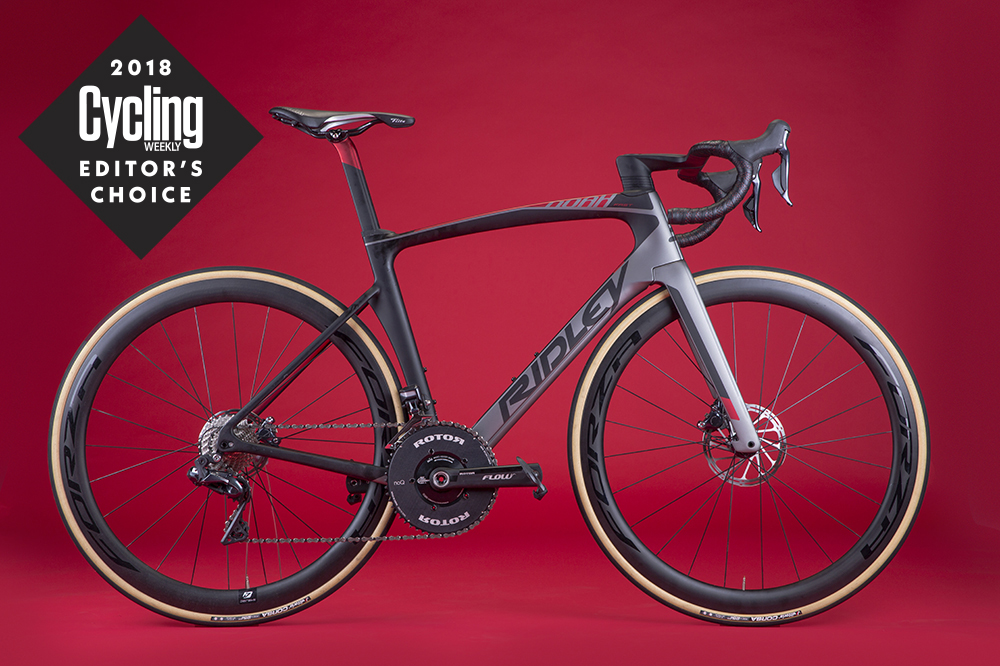
The Ridley Noah Fast Disc is a first rate aero machine, with Ridley using its aerodynamic expertise and its own wind tunnel to really hone the bike’s aero features and high speed stability. It’s not quite as smooth a ride as some aero bikes though and transmits more vibration through the frame on bumpy UK roads.
-
+
State of the art aero road frameset
-
+
Good gear range
-
+
Clean front end looks
-
+
Excellent power transfer
-
+
Stable handling at speed
- +
-
-
Expensive
-
-
A little less compliant than best in class aero bikes
- -
You can trust Cycling Weekly.

Ridley has used its on-site windtunnel to develop new, faster tube profiles and improve the overall aerodynamics of the new Noah Fast, while saving 250g frame weight over its predecessor. The result is a bike that’s not only eye-catching but, as its name says, fast. It’s earned its place on our Editor’s Choice selection of the top products we’ve tested in 2018.
The new Ridley Noah Fast was launched last summer, in time for it to be ridden in the Tour de Suisse and Tour de France. It’s already achieved notable successes for André Greipel, who won two stages of the 2018 Tour of Britain on the bike in his swansong season at Lotto-Soudal.
Frame
As with many new aero bikes, the Ridley Noah Fast comes with disc brakes, although there’s a rim brake option too. Ridley says that it has taken special care on the aerodynamics of the disc brake version, using DT Swiss hubs with removable levers so that the thru-axles don’t contribute additional wind resistance.
Ridley has completely redesigned the frameset of the Noah Fast, using both CFD and its own wind tunnel to refine the bike’s aerodynamics. It says that the frame’s weight has dropped by some 250g from the previous generation Noah. That bike had aero slots in its fork blades, which have been dropped from the new frame.
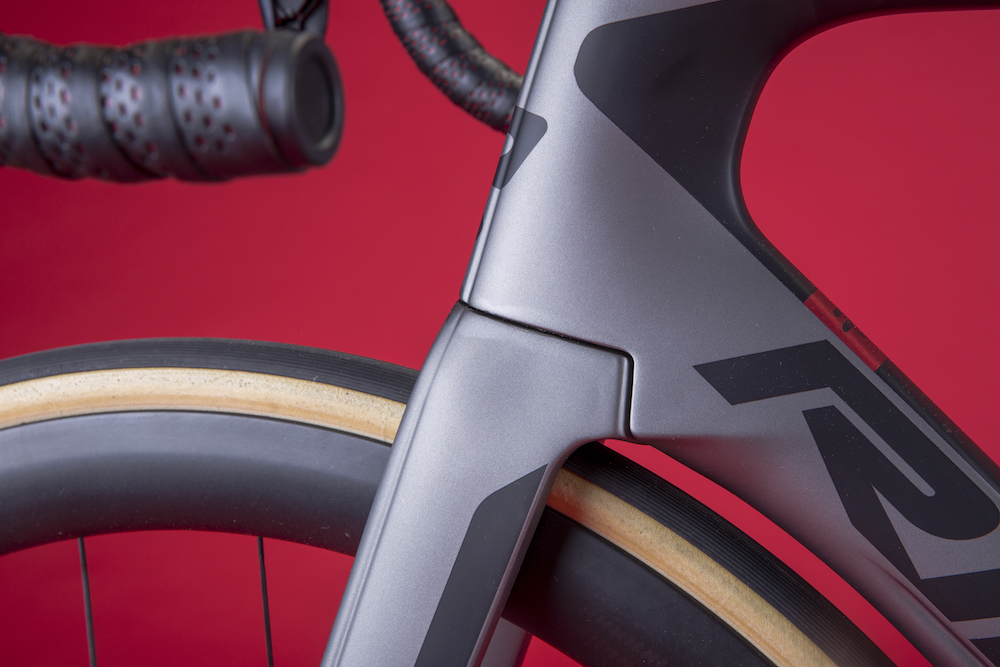
The Noah Fast Disc weighs 7.5kg as tested, while Ridley says that the rim brake version comes in under 7kg.
Other aero features include small winglets on the rear of the fork blade dropouts, like those on the Pinarello Dogma F10. The fork crown too is designed to mesh closely with the head tube for aerodynamic efficiency at a range of wind yaw angles.
The Ridley Noah Fast frameset has the expected kammtail aero tube shapes. There’s a notch in the leading edge of the down tube, a feature added to promote turbulent airflow and cause the air passing over the tube to follow the surface more closely, improving aerodynamic efficiency.
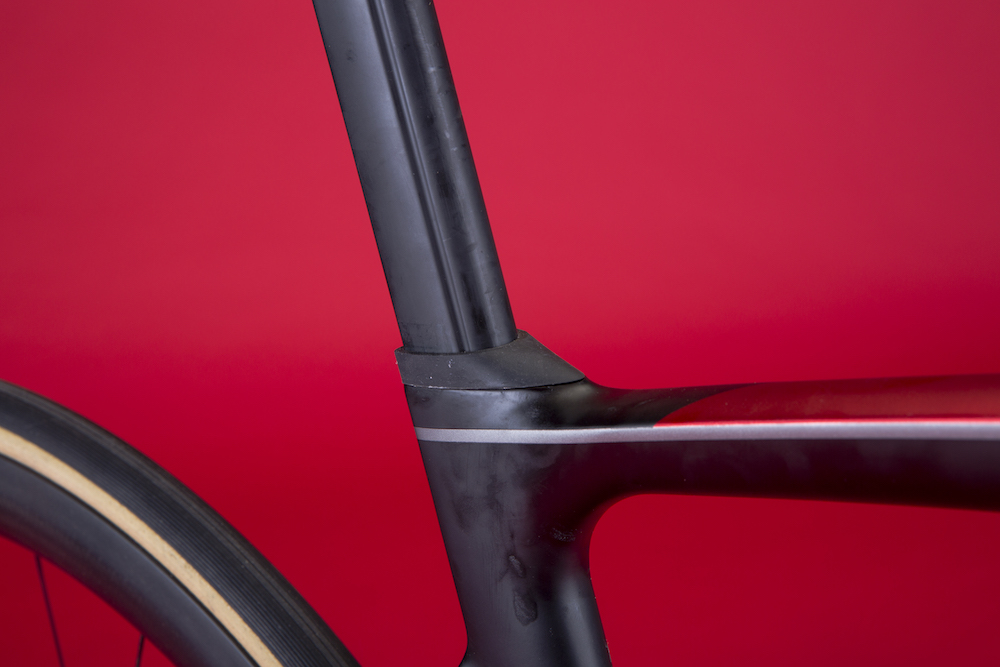
Ridley calls this its F-Surface Plus profile. It’s also used in the fork blade, the head tube and the seatpost of the Ridley Noah Fast. Unlike many bikes’ down tubes, the Ridley Noah Fast’s is quite narrow where it meets the bottom bracket shell, keeping its low wind profile.
The bottom bracket shell is chunky but quite narrow side to side, again avoiding excess wind resistance. There are protuberances from its side supporting the bottom bracket bearings.
There’s more of a curve to the top tube of the Ridley Noah Fast than with some aero bikes. This gives plenty of extension of the aero seatpost. The seat post clamp is in a cavity under a rubber cap in the top of the top tube. The cap doesn’t seat very closely, so it would be a good idea to check for water ingress if you take the bike out in the wet.
The seat tube has a distinct cut out for the rear wheel, while the seat stays adopt the typical low position found on aero bikes. The chainstays have a flattened profile, for a bit of extra vertical compliance.
The understated matt black-grey-red colour scheme looks the business too.
Specification
The Ridley Noah Fast Disc is available in the UK in just two specs: Ultegra Di2 and mechanical Ultegra. The Ultegra Di2 spec tested uses a Rotor Flow aero chainset with Rotor’s NoQ round chainrings, although it’s easy to swap out for elliptical Q-Rings if you prefer.
Gear ratios are 52/36 with an 11-30 cassette, rather than the more standard 11-28, adding the lower gears to get up hills more easily, while still giving you the top end ratios to take advantage of the fast aero ride on flat and downhill roads.
There’s a bar-end Di2 junction box and as with all Shimano’s latest electronic groupsets, you can set up synchronised and semi-synchronised front and rear mech shifting.
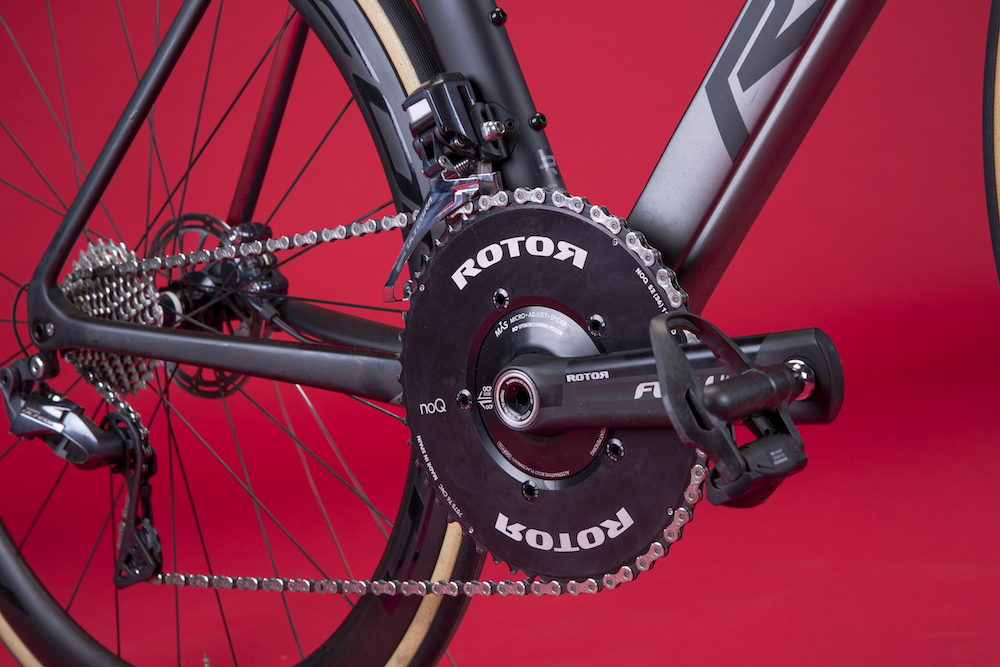
Ridley has designed an integrated aero cockpit for the Noah Fast. In disc brake spec, this results in a hidden cable run from the bars through the stem and into the frame. Opt for a rim brake bike and just the front brake cable runs externally. The design works with Shimano, Campagnolo and SRAM mechanical and electronic groupsets.
As you’d expect, this results in a very clean front end, with a narrow, flattened bar profile. There’s lots of bar height adjustability, as Ridley uses a mix of spacer heights, letting you adjust bar height in 1mm increments. Even the spacers have the F-Surface Plus notched aero profile. They’re split too, so you can adjust bar height without needing to remove the stem. There’s a range of effective stem lengths available between 90mm and 120mm, with different bar widths between 40cm and 44cm.
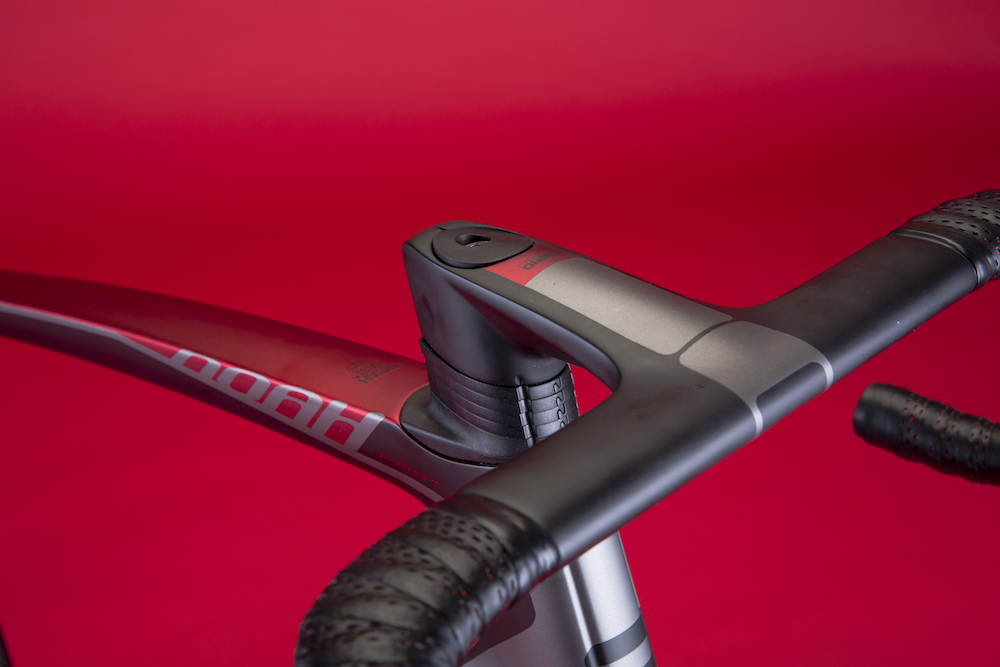
Ridley fits Forza R45 deep section carbon wheels from its own Forza component brand. The 19mm internal, 26mm external rim width is designed for tyres from 23mm up to 32mm width.
The wheels suit the bike’s aero looks although the internal nipples will make truing harder. Ridley quotes a wheelset weight of 1528g. They come with Vittoria Corsa 25mm tyres and sit on the well regarded DT Swiss 350 straight pull hubs. With the wider rims, the tyres come up closer to 28mm than 25mm, allowing you to drop the pressure.
Riding the Ridley Noah Fast Disc
As you’d expect from an aero machine, the Ridley Noah Fast Disc feels, well, fast. That’s particularly noticeable on flat-out downhill runs, where the Ridley feels very stable riding in the drops without the twitchiness that some machines exhibit. Crosswind stability is also good, with none of the buffeting that the combination of deep tube sections and disc rotors can cause for some aero machines.
Everything feels very taut and there’s a degree of steering precision which adds to confidence at speed, while there’s the reassurance of the disc brakes when you do need to slow yourself down.
The flip side is a rather less comfortable ride than, say on the Scott Foil – although that bike has been ridden to a win at Paris Roubaix, so you’d expect it to have plenty of compliance.
The Ridley Noah Fast Disc does transmit more road vibration to you when riding on the UK’s bumpy road surfaces. It’s not sufficient that it becomes tiring though. The wide, flat aero bar tops help spread the load on your palms when riding on the tops and the carbon lay-up helps adsorb vibration.
I may not put the power through the Ridley Noah Fast of André Greipel in the finishing straight, but the frameset feels suitably rigid for the finale of a sprint stage and for excellent power transfer on climbs. The 30 tooth largest sprocket means that you’re unlikely to run out of gears either.
It’s worth noting that Ridley’s bike sizes run large, with the small frame tested having a 54.5cm top tube length, equivalent to a medium for many bike brands. But the sloping top tube means that you get plenty of seatpost extension, adding compliance and promoting the head-down position that reduces the rider’s frontal profile and thus air resistance.
Value
£7189 is a lot of money to spend on a bike. But it’s not out of line with aero disc brake bikes from other makers. For the price, you’re getting the benefits of Ridley’s aerodynamic expertise and its considerable investment both in its wind tunnel and its on the road experience with the Lotto-Soudal pro team.
The Ridley Noah Fast range starts at £5459 for the rim braked bike and £5909 for the disc braked machine, both with mechanical Ultegra, so there are lower priced options available.

Thank you for reading 20 articles this month* Join now for unlimited access
Enjoy your first month for just £1 / $1 / €1
*Read 5 free articles per month without a subscription

Join now for unlimited access
Try first month for just £1 / $1 / €1
Get The Leadout Newsletter
The latest race content, interviews, features, reviews and expert buying guides, direct to your inbox!
Paul started writing for Cycling Weekly in 2015, covering cycling tech, new bikes and product testing. Since then, he’s reviewed hundreds of bikes and thousands of other pieces of cycling equipment for the magazine and the Cycling Weekly website.
He’s been cycling for a lot longer than that though and his travels by bike have taken him all around Europe and to California. He’s been riding gravel since before gravel bikes existed too, riding a cyclocross bike through the Chilterns and along the South Downs.
-
 'It took everything' - Puck Pieterse outclimbs Demi Vollering to win La Flèche Wallonne
'It took everything' - Puck Pieterse outclimbs Demi Vollering to win La Flèche WallonneDutch 22-year-old shows Classics pedigree with first one-day victory
By Tom Davidson Published
-
 Tadej Pogačar flies to dominant victory at La Flèche Wallonne
Tadej Pogačar flies to dominant victory at La Flèche WallonneSlovenian takes second win at Belgian classic ahead of Kévin Vauquelin and Tom Pidcock
By Tom Thewlis Published
-
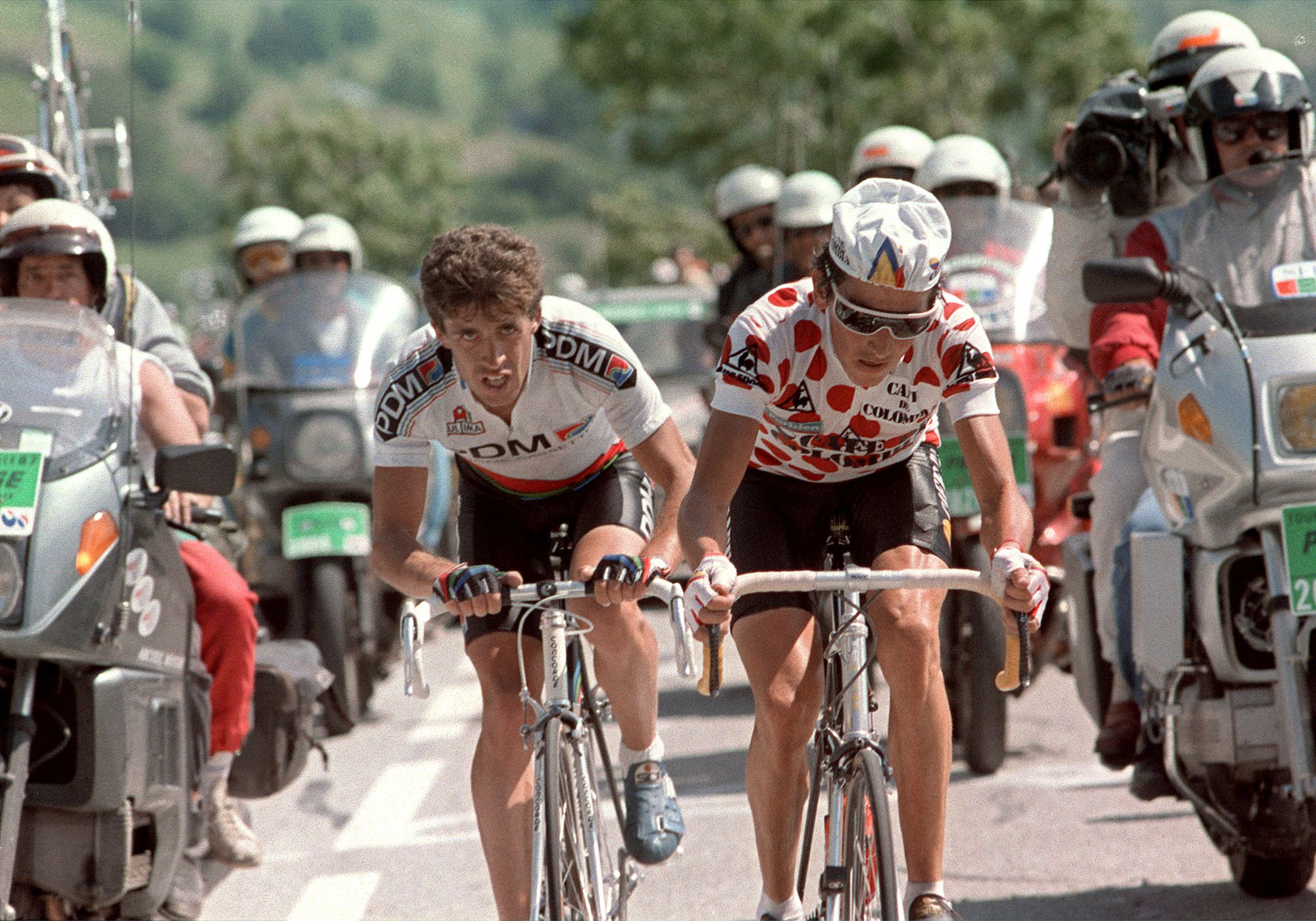 Colombian climbing star and former Vuelta a España winner Lucho Hererra could be investigated over murders of four people
Colombian climbing star and former Vuelta a España winner Lucho Hererra could be investigated over murders of four peopleA judge has called for an investigation into the former Vuelta winner who is alleged to have worked with paramilitary groups in Colombia
By Tom Thewlis Published